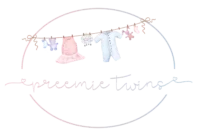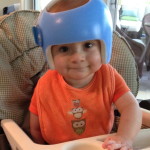Disclosure: This post may contain affiliate links, meaning we get a commission if you decide to make a purchase through our links, at no cost to you. Please read our disclosure for more info.
It seems like the recommendations for safe baby sleeping are always changing and it can be hard to keep up. We are now told to place our babies on their backs to sleep, which is very different from the tummy or side position babies that was recommended for previous generations.
The risk of Sudden Infant Death Syndrome (SIDS) has reduced dramatically since babies have been put to sleep on their backs, but as a consequence, a new problem, baby flat head syndrome, is becoming increasingly common.
It is estimated that this condition affects anywhere from 1/3 to ½ of all babies who sleep on their backs, and premature twins are at higher risk. It is so important that you continue to place your babies on the back to sleep, however it is also critical that you understand how to prevent flat spots on the head as a consequence.
In This Post:
Premature Twins Are at Even Greater Risk
Although research cannot predict which babies will have this problem, some risk factors have been clearly identified. Being cramped in the uterus can increase the risk of flat head syndrome in any baby and it has been proven that multiple birth infants are at higher risk due to this. With twins, the infant in the lower position is particularly vulnerable.
Premature babies are also at higher risk for additional reasons. They often spend much more time than full term infants resting in the same position on their backs in the NICU, and their skulls are that much softer than a full term infant’s. The cranial bones normally strengthen during the final ten weeks of pregnancy.
What Exactly Is Flat Head Syndrome?
Flat head syndrome is used to refer to a group of conditions that result in some type of flattening of the head. Usually it is caused by positioning, either in the womb, after birth, or a combination of the two. However, there can be other more serious causes so it is very important to get an accurate diagnosis if you notice any flat areas on your baby’s head.
The most common types are positional plagiocephaly, which affects one side of the back of the head, and brachycephaly, which is more symmetrical flattening across the entire back of the head, and can give the head an almost cone like appearance. Plagiocephaly is very common in babies diagnosed with torticollis, also known as ‘wry neck’, which is a tightening of the muscles on one side of the neck.
The result can be a disfiguring of the baby’s head, and in more severe cases one ear may shift forward, the forehead will bulge on one side, and there will be asymmetry of the facial features. Although these conditions are primarily considered cosmetic, they have also been associated with developmental delays, and in more serious cases conditions such as Temporo Mandibular Joint disorder (TMJ) and misalignment of the jaw.
More serious but occurring much less frequently, craniosynostosis is a premature closing of the plates in the skull that can also affect growth of the brain and can be only treated with surgery. It is critical that your baby is evaluated for this condition early if you notice any flattening of the head.
What Can Be Done to Prevent or Treat This Problem?
There are a number of things you can do to reduce your babies’ risk of developing flat head syndrome, and these same strategies will also promote healthy and normal infant development. These include:
- Changing the position your baby sleeps in the crib so the baby looks in different directions to see into the room
- Lots of tummy time – start early and do this often to avoid developmental delays and reduce pressure on the back of the head
- Limit time spent in strollers, car seats, swings, and bouncy seats, but when you do, you can use a special type of baby pillow to help reduce pressure on the same area of the head
- Repositioning techniques can help if your baby is already showing signs of flat spots and you start early
If you have tried these techniques and your baby’s head is still flat, a baby helmet, or cranial molding orthotic device, can be used to correct it. If you have any concerns about the shape of your infant’s head, be sure to speak with your pediatrician and do not hesitate to get a second opinion if you are still concerned. A specialist can take measurements and determine the severity of the problem, but it’s best to get an evaluation as early as possible, by the time the baby is four to six months old.
For more information on preventing and treating this condition, please visit the baby flat head syndrome blog.

